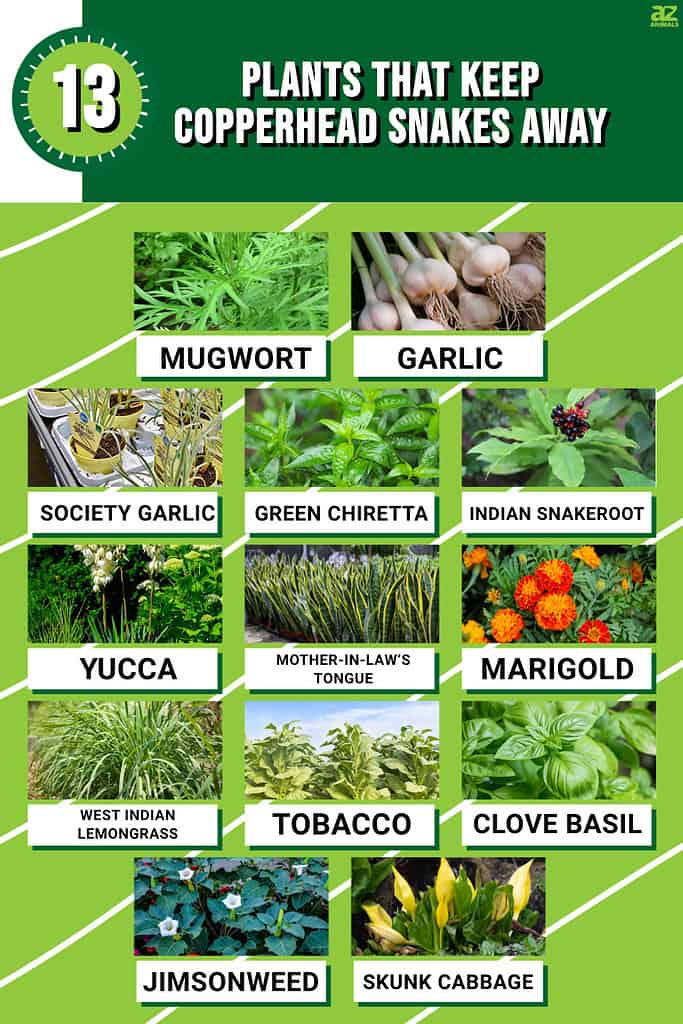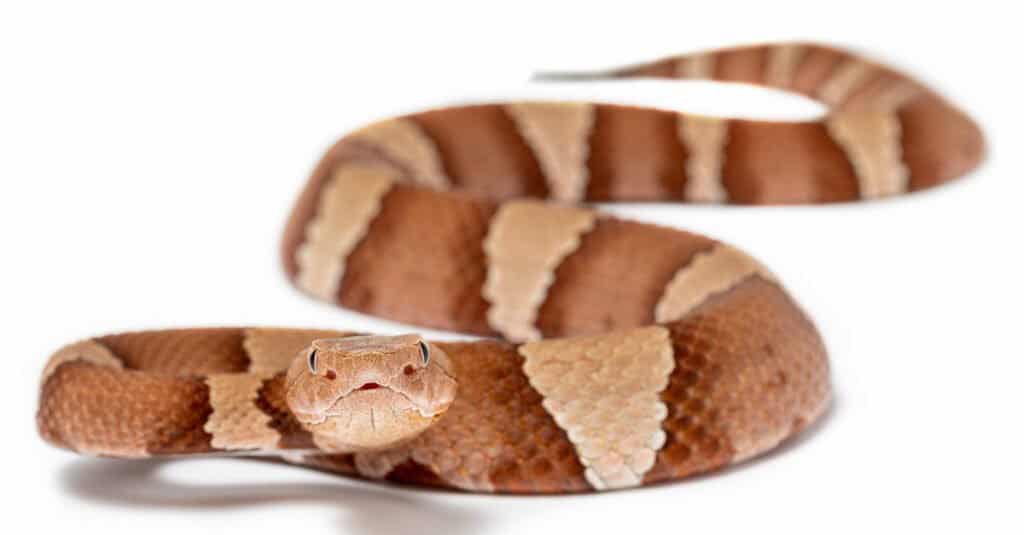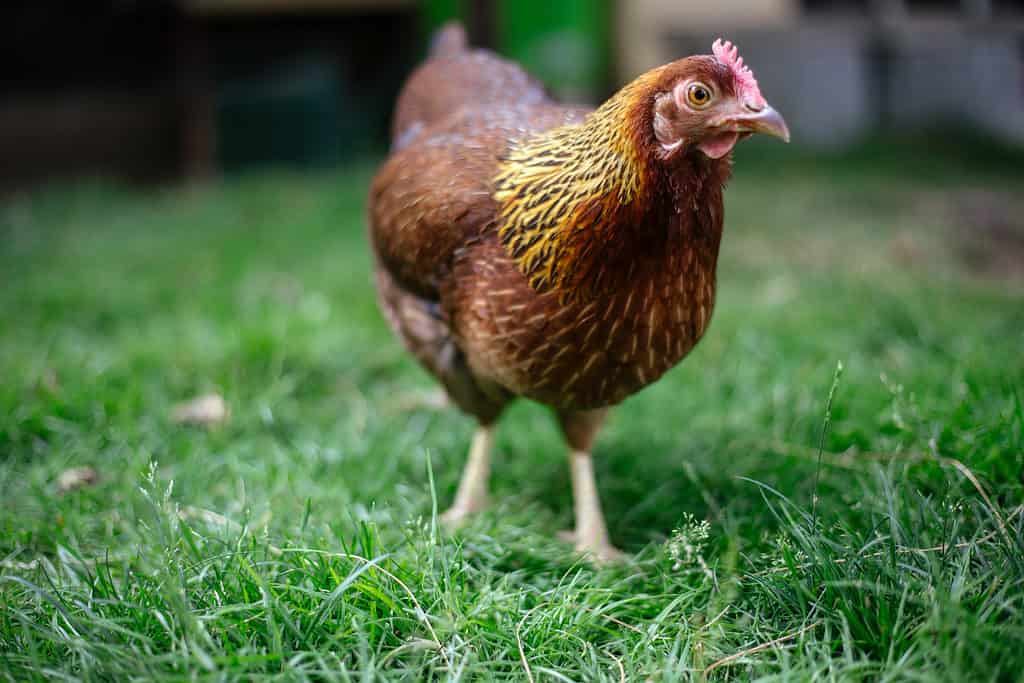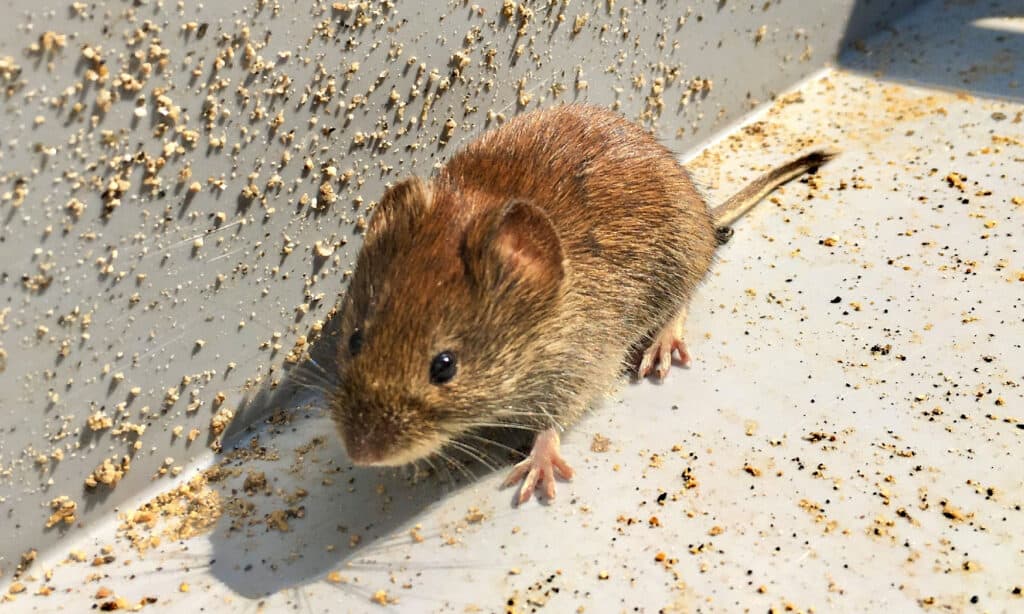Key Points:
- Copperheads are beautiful but dangerous snakes whose bite venomous bite is extremely painful.
- There are no plants that keep copperheads away.
- There are proven steps you can take to make your garden unwelcoming towards them.
Introduction
Nature has its own set of pest controls, whether it’s a plant or another creature. Some plants repel mosquitoes and ants, others may be unpleasant for rodents.
Given that many people are terrified of snakes—you may be one of them! If so, you’re probably wondering whether any of those bug-repellant plants will also work to keep copperheads away.
Unfortunately, that answer is no. However, we’ll dig into this and give you some solid advice you can use to minimize the snakes in your yard or garden.

How to Identify a Copperhead (Agkistrodon contortrix & A. laticinctus)
To know what you’re trying to repel, first you must identify it! Eastern copperheads are beautiful snakes. They have copper to bronze-colored heads and crossbands that can look like hourglasses or chocolate kisses. Its base color ranges from light gray or tan to pinkish-tan.
The broadband copperhead is similar, and once you can identify a copperhead it’s unmistakable. The biggest difference is that the markings don’t narrow toward the spine and stay wide all the the way through.
Smallish for pit vipers, the biggest ones only reach about 37 inches long. Although small, they have thickset bodies and proportionately large heads with thin necks common to pit vipers.
Their markings are perfect camouflage in the leaf-litter, and even on the trees they climb for crunchy bug treats!

The broadband copperhead’s markings stay wide all the the way through its body.
©Scott Delony/Shutterstock.com
Where Do Copperheads Live?
Eastern copperheads are common in the eastern half of the U.S., from about the eastern half of Texas to the Atlantic Coast and from Nebraska south. Broadband copperheads only inhabit a small strip from Texas to southern Kansas.
Both species prefer hiding in plain sight among the leaf litter. Their camouflage makes them nearly invisible. This is why people get bitten—they’re that hard to see! However, when the cicadas come out in early summer, some copperheads take to the trees after them.
How to Keep Copperheads Away and Out of Your Garden
As previously mentioned, there aren’t any plants (or even commercial repellants) that have been definitively proven to repel snakes of any type.
However, there are several things you can can to keep snakes away naturally by remembering the simple fact: Snakes follow their prey and seek shelter.
Close off openings into your home
This may go without saying, but snakes need safe places to hibernate, known as brumation in reptiles. Many basements and crawl spaces have become impromptu snake dens because there was an opening large enough squeeze into. They don’t need a very large opening either, just big enough to get their heads through before wriggling the rest of the way in.
Seal up any cracks and crevices with silicone or another water-tight sealant.
Clean up all debris
Piles of brush, leaves, and even woodpiles all serve as homes for copperhead snakes and the animals they eat. Think of it this way: if a small mouse or rat can find shelter, so can a snake.
We know that woodpiles are important for the winter, many of us use wood to heat our homes. However, find ways to keep debris from collecting around the woodpile and keep it on a rack at least a foot off the ground. It will minimize the critters that turn it into a home.
Get chickens or Guinea hens

©Katrin Friedl Fotografie/Shutterstock.com
Yes, these birds will keep snakes at bay. They’re also fun to watch and you can eat the eggs.
They’ll clean up any bugs and mice that the snake eat, in addition to taking your kitchen vegetable scraps and providing furniture.
Keep grass and hedges trimmed
Snakes like to hide in tall grasses and under bushes. Keeping them trimmed shorter makes them less inviting for snakes.
Install snake fencing
Snake fencing is a fine-meshed product where the opening are small enough that snakes and other small animals can’t fit through. It’s pretty successful at keeping some of the snakes out. However, that’s all predicated on doing the other things that reduce the prey available, because snakes can climb.
Remove water sources
Snakes, like their prey, need water. Backyard ponds are gorgeous, but if you’re trying to avoid snakes, avoid putting out a welcome mat. Their prey will be there for the water, the copperheads will come for the water and the prey.
Remove standing water wherever possible.
Snake repellants
According to an article in the AP News, they don’t work. Follow the tips here, and you’ll be much more successful in your attempts to keep copperheads away—even though they are pest control specialists.
Plants That Might Repel Insects & Other Pests
While snakes don’t give two bits about spiky or smelly plants, some of their prey does care! If you think about it, it makes sense. Since snakes follow the food, if a plant or three makes that food source unwilling to stay, then the snakes won’t stay either. So, in an indirect sort of way, perhaps the plants help—just not directly.

Snakes are attracted to their prey—mice are on their menu!
©iStock.com/Bruno_il_segretario
Here are a few plants that may reduce the number of critters attracting snakes to your yard.
- Mugwort
- Garlic
- Society Garlic
- Green Chiretta
- Indian Snakeroot
- Yucca
- Mother-in-Law’s Tongue
- Marigold
- West Indian Lemongrass
- Tobacco
- Clove Basil
- Jimsonweed
- Skunk Cabbage
Is There Anything Else That Repels Copperheads?
Not really. These are the most effective and proven practices to keep all snakes, not just copperheads, out of your yard.
If, after doing everything in the article, you still have copperheads, consider calling an expert to help you. They may see something that you’ve missed.
The photo featured at the top of this post is © Suzanna Ruby/Shutterstock.com
Thank you for reading! Have some feedback for us? Contact the AZ Animals editorial team.






